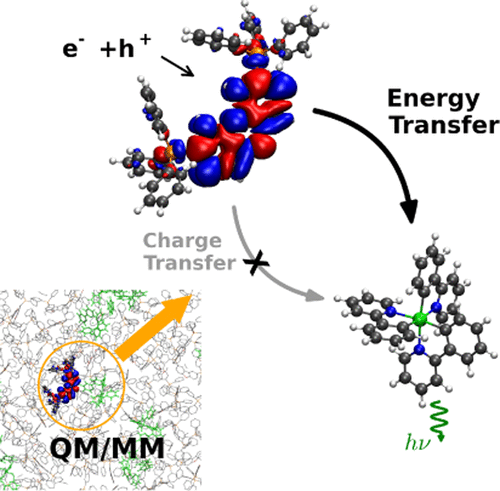当前位置:
X-MOL 学术
›
J. Phys. Chem. C
›
论文详情
Our official English website, www.x-mol.net, welcomes your
feedback! (Note: you will need to create a separate account there.)
Unraveling the Fate of Host Excitons in Host–Guest Phosphorescent Organic Light-Emitting Diodes
The Journal of Physical Chemistry C ( IF 3.3 ) Pub Date : 2019-04-16 , DOI: 10.1021/acs.jpcc.9b02820 Tianyu Zhu 1 , Troy Van Voorhis 1
The Journal of Physical Chemistry C ( IF 3.3 ) Pub Date : 2019-04-16 , DOI: 10.1021/acs.jpcc.9b02820 Tianyu Zhu 1 , Troy Van Voorhis 1
Affiliation

|
Understanding the energy- and charge-transfer mechanisms in host–guest systems is crucial for improving the performance of organic light-emitting diodes (OLEDs), but it presents a theoretical challenge because of the disordered molecular environment. Here, we address the fate of excitons that form on the host in a 2,8-bis(triphenylsilyl)dibenzofuran–Ir(ppy)3 phosphorescent OLED through a quantum mechanics/molecular mechanics simulation. Our results demonstrate that triplet host excitons can be harvested through efficient energy transfer to the T1 state of the guest allowed by an excellent spectral overlap. A detailed analysis of the guest absorption spectrum uncovers the fact that high-lying guest singlet states play a critical role in utilizing singlet host excitons. Furthermore, we investigate the process where host excitons break up and re-form on the guest and show it is unfavored owing to the high energy barrier. This work thus reveals that energy transfer is the primary quenching mechanism for host excitons and highlights the strategies for a better host–guest design.
中文翻译:

揭示宿主-客体磷光有机发光二极管中宿主激子的命运
了解主机系统中的能量和电荷转移机制对于提高有机发光二极管(OLED)的性能至关重要,但是由于分子环境混乱,因此在理论上提出了挑战。在这里,我们通过量子力学/分子力学模拟研究了在2,8-双(三苯基甲硅烷基)二苯并呋喃–Ir(ppy)3磷光OLED中形成在宿主上的激子的命运。我们的结果表明,三重态宿主激子可以通过有效的能量转移到T 1来获得极佳的光谱重叠使宾客的状态得以改善。对客体吸收光谱的详细分析揭示了一个事实,即高客体单重态在利用单重态宿主激子中起着至关重要的作用。此外,我们研究了宿主激子在客体上分解并重新形成的过程,并表明由于高能垒,它是不利的。因此,这项工作揭示了能量转移是宿主激子的主要淬灭机制,并强调了更好的宿主-客体设计的策略。
更新日期:2019-04-17
中文翻译:

揭示宿主-客体磷光有机发光二极管中宿主激子的命运
了解主机系统中的能量和电荷转移机制对于提高有机发光二极管(OLED)的性能至关重要,但是由于分子环境混乱,因此在理论上提出了挑战。在这里,我们通过量子力学/分子力学模拟研究了在2,8-双(三苯基甲硅烷基)二苯并呋喃–Ir(ppy)3磷光OLED中形成在宿主上的激子的命运。我们的结果表明,三重态宿主激子可以通过有效的能量转移到T 1来获得极佳的光谱重叠使宾客的状态得以改善。对客体吸收光谱的详细分析揭示了一个事实,即高客体单重态在利用单重态宿主激子中起着至关重要的作用。此外,我们研究了宿主激子在客体上分解并重新形成的过程,并表明由于高能垒,它是不利的。因此,这项工作揭示了能量转移是宿主激子的主要淬灭机制,并强调了更好的宿主-客体设计的策略。































 京公网安备 11010802027423号
京公网安备 11010802027423号